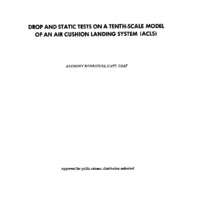-
Title
-
Drop and Static Tests on a Tenth-Scale Model of an Air Cushion Landing System (ACLS)
-
Date
-
1973
-
Index Abstract
-
Not Available
-
Photo Quality
-
Complete
-
Report Number
-
AFFDL TR 73-46
-
Corporate Author
-
Air Force Institute of Technology
-
Laboratory
-
Air Force Flight Dynamics Laboratory
-
Extent
-
160
-
Identifier
-
AD0770026
-
Access Rights
-
Approved for public release; distribution unlimited
-
Distribution Classification
-
1
-
Contract
-
Laboratory Research - No Contract
-
DoD Project
-
1369
-
DoD Task
-
None Given
-
DTIC Record Exists
-
Yes
-
Distribution Change Authority Correspondence
-
None
-
Distribution Conflict
-
No
-
Abstract
-
An experimental investigation of the performance of an Air Cushion Landing System (ACLS) on a one-tenth scale model of a CC-115 Canadian aircraft is discussed. Several different types of tests were conducted on an extended version of the ACLS trunk at simulated fullscale trunk pressures of 315 psfg, out of ground effect, and 342 psfg, in ground effect. Cushion pressure was 160 psfg, in ground effect, during hover. The experiments involved: vertical drop tests to measure the effects of sink rate and initial attitude between full- scale sink rates of 3.0 and 12.5 fps, and attitudes of pitch and roll from 0.0 to 12.0 and 0.0 to 7.5 degrees, respectively; static equilibrium tests to measure vertical stiffness, roll stiffness, pitch stiffness, and floor pressure exerted by the ACLS with loads up to 4.1 times the aircraft landing weight; and braking tests to obtain the effects of changing brake pillow thickness between simulated full-scale heights of 0.0 inches and 26.0 inches. The results of the vertical drop tests revealed that the air cushion will absorb most of the landing impact load except at initial attitudes of 12.0 degrees pitch, where the aircraft fuselage could touch the ground. Vertical stiffness test results showed the extended version of the ACLS trunk to be 39% stiffer than a previous shorter version between vertical load ranges of 0.5 and 1.9 times the aircraft landing weight. Floor pressure tests verified that the ACLS aircraft could land on low strength runways and never exert pressures higher than 3.8 psi above the atmospheric, full scale. Braking tests concluded that maximum deceleration of the aircraft was about 0.34 g, and that increasing pillow thickness above 10.8 inches, full scale, would not increase that deceleration rate.
-
Report Availability
-
Full text available
-
Date Issued
-
1973-09
-
Provenance
-
Bombardier/Aero
-
Type
-
report
-
Format
-
1 online resource
-
Creator
-
Rodrigues, Anthony
 AFFDLTR73-046.pdf
AFFDLTR73-046.pdf